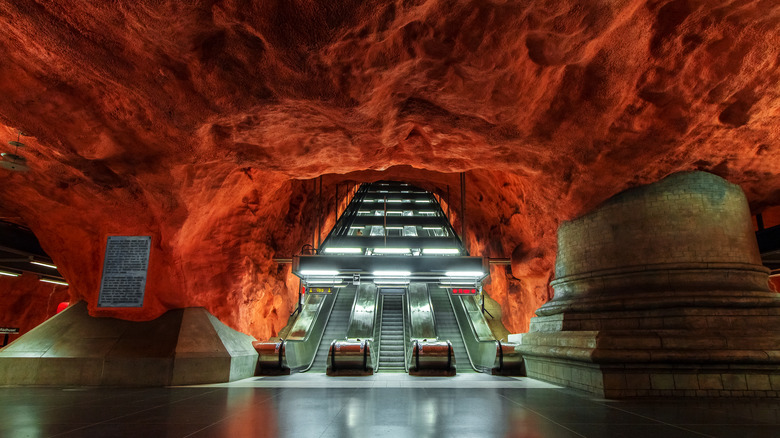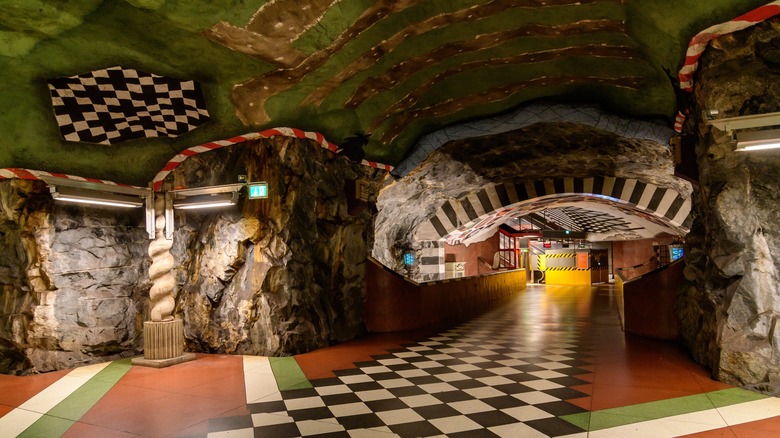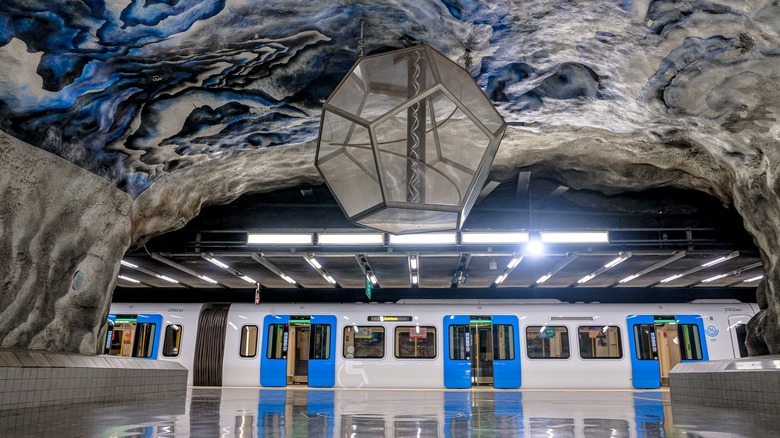Why Travelers Say Stockholm, Sweden's Train Stations Feel So Otherworldly
From grim fluorescent lighting and train delays to lackluster hostile design and deplorable overcrowding, most people can probably agree that metro stations aren't the most exciting places in the world. Commuters worldwide from New York to Paris tend to lament their dreaded commutes, and for good reason. However, this is not the case in Stockholm, Sweden. Although Stockholm is one of the friendliest cities in the world, there is a mystical dimension to this city's charm that leaves travelers, and surely locals too, in awe — its train stations. Described, perhaps most aptly, as "otherworldly," Stockholm's subway system, known as the Tunnelbana, transforms the mundane act of commuting into an immersive artistic experience.
Tunnelbana is often referred to as the world's longest art gallery, stretching for nearly 70 miles and featuring art at 90 of its 100 stations. The system is divided into the green, red, and blue subway lines, with 47 underground and 53 above-ground stations. This expansive project began in the 1950s, with the latest installation finished in 2017. The goal? To make art accessible to everyone. Each station boasts unique themes, artworks, and designs, turning a simple commuter's journey into a subterranean cultural adventure. From intricate mosaics and sculptures to vibrant murals and installations and the incorporation of natural rock formations, the diversity of styles and mediums in Stockholm's train stations is astonishing, with over 150 artists contributing to the project. Bring your camera and sense of adventure as you descend into the depths of the Tunnelbana!
Stockholm's Tunnelbana metro stations
It would be impossible to detail each of the 90 art-laden Tunnelbana stations — it's best you go and see them for yourself — but here are some of the standout ones. T-Central, the central station of Stockholm's subway system, was the first to feature artworks. Artist Per Olof Ultvedt used serene blue tones and patterns that evoke a sense of tranquility, balancing the bustling atmosphere of the city's central hub. The Solna Centrum station, done by artists Karl-Olov Björk and Anders Åberg, immerses travelers in a surreal landscape with its deep red walls and green forest motifs, reflecting environmental themes and the beauty of Swedish nature.
Many of the artworks in the Tunnelbana are imbued with historical and cultural significance, offering insights into Sweden's heritage. At the Kungsträdgården station, for example, the design reflects the history of the nearby public park (one of Stockholm's oldest), incorporating elements from the 17th and 18th centuries with dramatic ruins, statues, and artifacts. Stadion subway station — one of Stockholm's first cave stations, the main area for the Stockholm Pride festival, and the station that leads you to the Olympic Stadium (which hosts concerts and sports events) — is iconic, with rainbows and bright blues painted on the cave walls, done by Åke Pallarp and Enno Hallek in 1973. Beyond the sheer beauty of all the art, the subway is also very tidy — Stockholm itself is one of the world's cleanest cities.
Mysterious places and how to explore the Tunnelbana
On a more supernatural level, some lore surrounds Stockholm's otherworldly subway. The "Silver Train" (Silverpilen) is a legendary ghost train in the city's metro. Originally, it was a real train, the unpainted aluminum C5 model, distinct from the regular green or blue trains. Introduced in the mid-1960s and used infrequently until the mid-1990s, its rarity and eerie appearance gave rise to spooky tales.
According to urban legends, the Silverpilen appears at deserted stations, carrying ghostly passengers, and occasionally stops to pick up unsuspecting travelers who are never seen again. If you don't want to end up on this poltergeist-cursed train, check out our subway travel tip. Another mysterious place is the unfinished and abandoned Kymlinge Station that never opened to the public — the ghostly Silverpilen reportedly stops there. If you dare, you can see the station from outside or en route after Hallonbergen station toward Akalla.
Horror stories aside, to explore Stockholm's Tunnelbana, you can purchase a basic ticket for 42 SEK ($4), which is valid for 75 minutes, allowing you to get off at a handful of stations and look around — a good option if you have limited time in your itinerary. Otherwise, you can spend a little more on the 24-hour ticket, which costs 175 SEK (nearly $17) but will give you the freedom to spend the day (or night) exploring as many stations as possible. You can also join the Stockholm Subway Art Tour, a guided experience.


